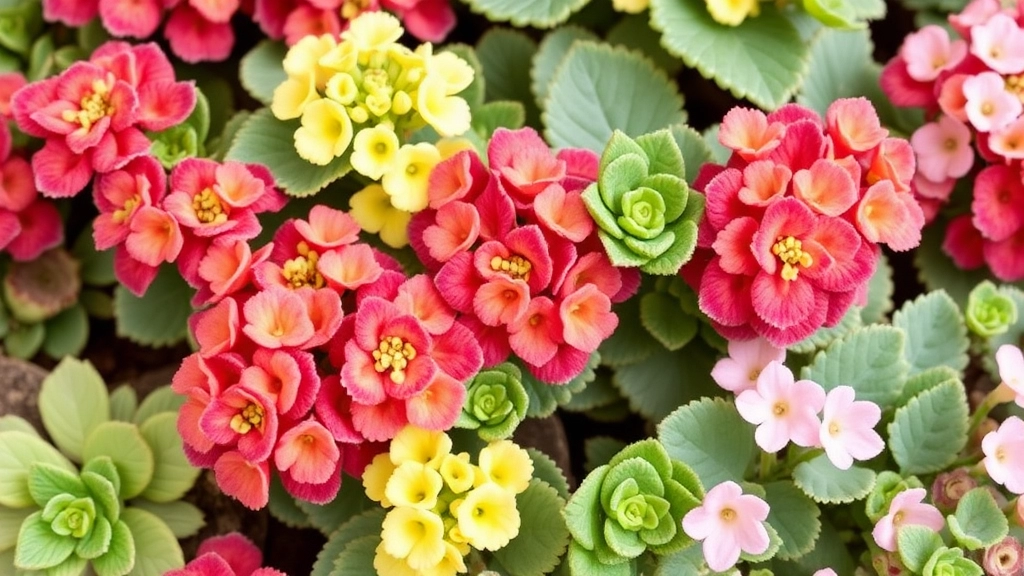Kalanchoe Flapjack Varieties
When it comes to Kalanchoe Flapjack Varieties, there’s a lot to explore. These unique succulents, known for their thick, paddle-shaped leaves, come in several types, mainly Kalanchoe thyrsiflora and Kalanchoe luciae. Each variety brings its own charm and care requirements, making them a favourite among gardeners and plant enthusiasts.
Understanding the Differences
Understanding the differences between Kalanchoe luciae and Kalanchoe thyrsiflora can help you choose the right plant for your garden. While they may look similar, their leaf colour and flowering habits vary. Dive into the world of Kalanchoe Flapjack Varieties to discover the best care practices, soil types, and propagation methods to keep your plants thriving.
Are you curious about the different types of Kalanchoe flapjacks?
Kalanchoe, a popular succulent, boasts several varieties, each with its unique charm.
## Main Varieties
– **Kalanchoe luciae**
– Known for its striking, large, paddle-shaped leaves.
– The leaves often exhibit vibrant red or orange edges when exposed to sunlight.
– **Kalanchoe thyrsiflora**
– Often referred to as “Flapjack” due to its distinctive shape.
– Features a more rounded leaf structure compared to Kalanchoe luciae.
– **Kalanchoe orgyalis**
– Distinguished by its fuzzy, velvety leaves.
– Displays a unique coppery hue, adding an interesting texture to your collection.
– **Kalanchoe beharensis**
– Known as “Elephant Bush,” it has larger, more elongated leaves.
– The leaves often have a silvery-green appearance, providing a different aesthetic. For more detailed information, check out the [complete care guide for Kalanchoe beharensis](https://planthq.org/complete-care-guide-for-kalanchoe-beharensis-felt-plant/).
– **Kalanchoe marnieriana**
– This variety has narrower leaves that are more upright.
– Its leaves also display a beautiful blend of green and red tones.
Each of these varieties brings something special to the table, whether it’s colour, texture, or overall appearance. If you’re looking to propagate some of these varieties, you might find this [step-by-step guide on Kalanchoe propagation from leaves](https://planthq.org/stepbystep-guide-kalanchoe-propagation-from-leaves/) helpful.
Characteristics of Kalanchoe Luciae
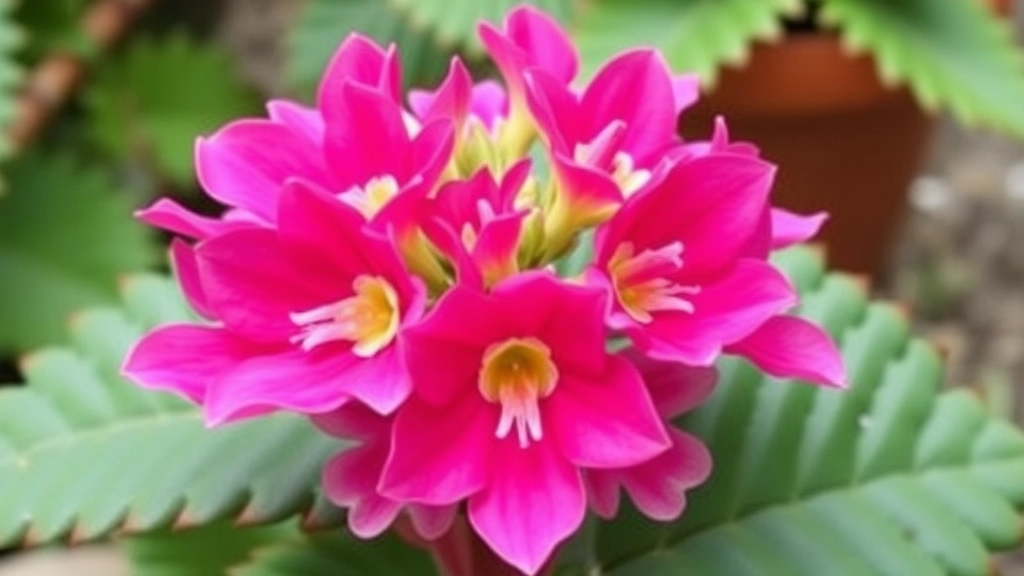
So, you’re curious about Kalanchoe Luciae, also known as Flapjacks? You’re in for a treat!
Unique Features
Kalanchoe Luciae is a succulent that really stands out.
- Leaf Shape: Its leaves are thick and paddle-like, resembling little pancakes stacked on top of each other.
- Colour: When exposed to bright sunlight, the leaves can take on stunning shades of red and orange, making them a real eye-catcher in any garden.
- Height: This plant can grow up to 30 cm tall, creating a lovely focal point.
- Flowers: While it’s primarily grown for its foliage, Kalanchoe Luciae does produce small, tubular flowers in clusters during the blooming season, typically in late winter to early spring.
Growing Conditions
Kalanchoe Luciae thrives in bright, indirect light.
- Watering Needs: It prefers a good soak followed by a dry spell, so don’t overdo it.
- Soil Preference: Well-draining soil is a must to prevent root rot.
Hardiness
This beauty is quite resilient, thriving in USDA hardiness zones 9b to 11.
- Temperature: It’s best kept in warmer conditions, ideally above 10°C.
When it comes to Kalanchoe flapjacks, many enthusiasts often find themselves torn between Kalanchoe luciae and Kalanchoe thyrsiflora. Both varieties exhibit unique traits, but understanding their differences can significantly enhance your gardening experience.
Leaf Shape and Size
- Kalanchoe Luciae: Known for its larger, more rounded leaves, Kalanchoe luciae often resembles a stack of pancakes. The leaves can grow up to 15 cm long, creating a striking visual impact.
- Kalanchoe Thyrsiflora: In contrast, this variety features flatter, more elongated leaves that can reach about 10 cm in length. The overall appearance is somewhat more delicate compared to its counterpart.
Color Variations
- Kalanchoe Luciae: Typically showcases vibrant shades of green with a hint of red or purple along the edges, especially when exposed to bright sunlight.
- Kalanchoe Thyrsiflora: Tends to exhibit a more uniform green colour, though it can also develop a reddish tint when stressed by sunlight or drought.
Growth Habit
- Kalanchoe Luciae: Grows more upright, forming a compact rosette that can reach a height of around 30 cm.
- Kalanchoe Thyrsiflora: Spreads out more horizontally, creating a low-profile plant that usually stays under 20 cm in height.
Flowering
- Kalanchoe Luciae: When it blooms, it produces clusters of tubular flowers, typically in shades of yellow or orange. For a more detailed guide on how to grow and care for this variety, check out our [Kalanchoe Luciae Paddle Plant Care Guide](https://planthq.org/how-to-grow-and-care-for-kalanchoe-luciae-paddle-plant/).
- Kalanchoe Thyrsiflora: Also flowers, but its blooms are usually more sparse and can appear in clusters, often in a similar colour palette. To learn more about the propagation methods for this plant, visit our [How to Propagate Kalanchoe Flapjack Step-by-Step Guide](https://planthq.org/how-to-propagate-kalanchoe-flapjack-stepbystep-guide/).
Sunlight and Color Changes in Flapjack Succulents

Understanding how sunlight affects Kalanchoe flapjacks is essential for their vibrant growth and stunning colouration.
Many plant enthusiasts often wonder why their flapjack succulents, particularly Kalanchoe luciae and Kalanchoe thyrsiflora, sometimes appear dull or lack the vibrant hues they expect.
Sunlight Requirements:
- Bright, Indirect Light: Kalanchoe flapjacks thrive in bright, indirect sunlight.
- Direct Sunlight: While they can tolerate some direct sunlight, too much can lead to sunburned leaves.
- Indoor Placement: If grown indoors, a south-facing window is ideal for optimal light exposure.
Colour Changes:
- Sun Exposure: Adequate sunlight enhances the reddish or purplish tones in the leaves.
- Stress Response: Insufficient light can cause the plants to elongate and lose their vibrant colours, resulting in a more muted appearance.
For instance, I’ve noticed that my Kalanchoe luciae takes on a stunning reddish hue when it receives direct sunlight in the morning. Conversely, those kept in shadier spots often appear green and less visually striking.
Tips for Optimal Sunlight Exposure:
- Rotate your plants regularly to ensure even light distribution.
- Observe their response to sunlight; adjust their placement as needed.
Best Soil Types for Growing Flapjacks
When it comes to cultivating Kalanchoe flapjacks, the right soil is essential for their health and vitality. Many gardeners find themselves wondering what type of soil will best support these unique succulents.
Ideal Soil Composition
Kalanchoe flapjacks thrive in well-draining soil that mimics their native habitat. Here are the key components to consider:
- Cactus Mix: A pre-mixed cactus soil is a great option, as it typically includes sand and perlite for drainage.
- DIY Mix: You can create your own blend by combining:
- 50% potting soil
- 25% coarse sand
- 25% perlite or pumice
- pH Level: Aim for a slightly acidic to neutral pH (around 6.0 to 7.0) to promote optimal growth.
Drainage is Key
One of the most common issues with flapjack succulents is root rot, which often results from poor drainage. To prevent this, consider the following tips:
- Pot Choice: Use pots with drainage holes to allow excess water to escape.
- Layering: Place a layer of gravel or small stones at the bottom of the pot to enhance drainage.
Nutrient Considerations
While Kalanchoe flapjacks don’t require overly nutrient-rich soil, you can boost their growth with:
Watering Guidelines for Kalanchoe Flapjack Varieties
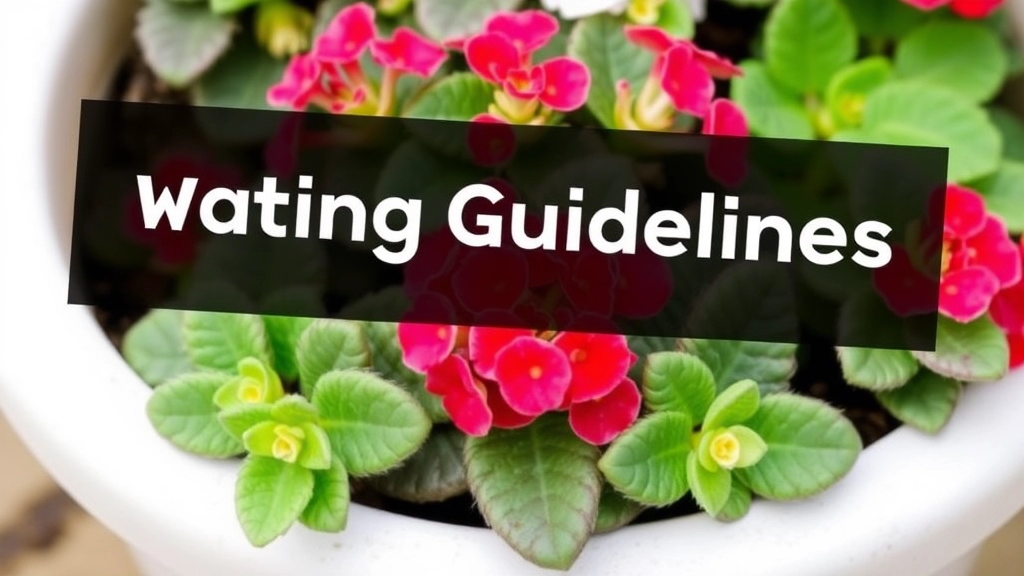
Wondering how much water your Kalanchoe Flapjack needs? You’re not alone! Many plant lovers struggle with the right balance.
Watering Basics
Kalanchoe Flapjacks, like Kalanchoe Luciae and Kalanchoe Thyrsiflora, are succulents, which means they store water in their leaves. This makes them pretty forgiving when it comes to watering. Here’s what to keep in mind:
- Soil Check: Always check the soil before watering. If the top inch feels dry, it’s time to give your plant a drink.
- Frequency: Generally, watering every 2-3 weeks is a good rule of thumb. In the winter, you can stretch this to every 3-4 weeks.
- Watering Method: Water deeply but infrequently. This encourages the roots to grow stronger. Pour water until it drains out of the bottom, then let it dry out completely before the next watering.
Signs of Overwatering
Keep an eye out for these signs that you might be overdoing it:
- Yellowing leaves
- Mushy stems
- A foul smell from the soil
If you spot these, cut back on the watering right away!
Signs of Underwatering
On the flip side, if your plant looks shriveled or the leaves feel crispy, it’s time to up your watering game.
In summary, the key to watering Kalanchoe Flapjacks is to let the soil dry out between waterings and always check the top inch.
When considering the optimal conditions for your Kalanchoe flapjacks, understanding temperature and hardiness zones is essential. Many plant enthusiasts often worry about whether their chosen varieties can thrive in their specific climates.
### Temperature Preferences
Kalanchoe flapjacks, particularly Kalanchoe luciae and Kalanchoe thyrsiflora, prefer warmer temperatures. They flourish best in:
– **Daytime temperatures**: 20°C to 30°C (68°F to 86°F)
– **Nighttime temperatures**: 10°C to 15°C (50°F to 59°F)
These succulents are not frost-tolerant. If exposed to temperatures below 5°C (41°F), they may suffer damage or even die.
### Hardiness Zones
Kalanchoe flapjacks typically thrive in USDA hardiness zones 10 to 11. This means they are best suited for regions with mild winters and warm summers. Here’s a quick breakdown:
– **Zone 10**: Minimum winter temperatures of 1°C to 4°C (30°F to 40°F)
– **Zone 11**: Minimum winter temperatures above 4°C (40°F)
If you live in a cooler climate, consider bringing your flapjacks indoors during the colder months or providing adequate protection.
### Tips for Temperature Management
To ensure your Kalanchoe flapjacks remain healthy, here are a few tips:
– **Indoor Placement**: If indoors, position them near south-facing windows for maximum sunlight.
– **Outdoor Care**: During colder months, bring them indoors or cover them with frost cloth.
– **Monitor Temperature**: Use a thermometer to keep track of indoor temperatures, especially during winter.
For more detailed care instructions, you might find our [complete care guide for Kalanchoe Blossfeldiana succulent](https://planthq.org/complete-care-guide-for-kalanchoe-blossfeldiana-succulent/) helpful. Additionally, if you are interested in exploring other varieties, check out our article on [top Kalanchoe varieties with pink edges](https://planthq.org/top-kalanchoe-varieties-with-pink-edges/).
Propagation Methods for Kalanchoe Flapjacks
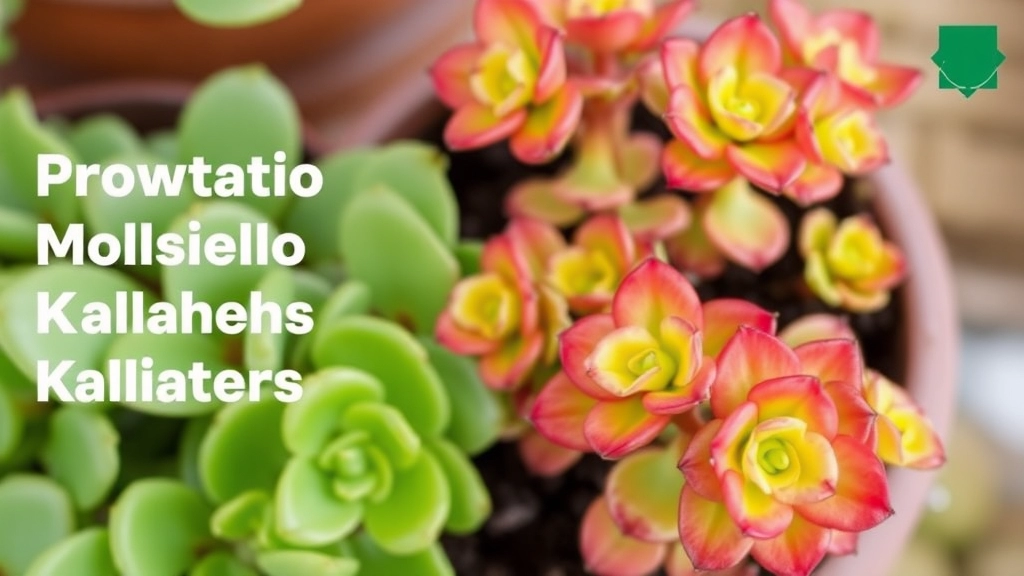
So, you’re looking to expand your collection of Kalanchoe flapjacks?
Propagation is a fantastic way to do it, and it’s easier than you might think.
Let’s dive into some simple methods to get those lovely succulents multiplying.
Leaf Cuttings
One of the most common ways to propagate Kalanchoe flapjacks is through leaf cuttings. Here’s how:
- Choose a Healthy Leaf: Pick a mature, healthy leaf from the parent plant.
- Let It Callous: Place the leaf on a dry surface for a few days. This helps the cut end to callous over, reducing the risk of rot.
- Plant It: Once it’s calloused, place the leaf in well-draining soil, burying the cut end slightly.
- Water Sparingly: Mist the soil lightly and keep it in a warm, bright spot.
Offsets
Kalanchoe flapjacks often produce offsets, which are small plants that grow at the base of the parent. Here’s how to propagate using offsets:
- Locate Offsets: Look for small rosettes at the base of the plant.
- Gently Remove: Use a clean knife to cut them away from the parent plant.
- Let Them Dry: Allow the offsets to dry for a day before planting.
- Plant: Place them in well-draining soil and water lightly.
Seeds
While not the most common method, you can also propagate Kalanchoe flapjacks from seeds:
- Collect Seeds: If your plant flowers, collect seeds once they’re mature.
- Sow in Soil: Plant them in a seed tray filled with light soil.
- Keep Moist: Mist the soil regularly to keep it moist but not soggy.
Tips for Success
- Temperature: Ensure the cuttings or offsets are kept in a warm environment.
- Light: Provide bright, indirect sunlight to encourage growth.
- Patience: It can take a few weeks for roots to develop, so hang tight!
Common Issues and How to Prune Flapjack Plants
As we delve deeper into caring for Kalanchoe flapjacks, it’s essential to address common issues that may arise. Understanding these challenges will help you maintain healthy plants and enhance their beauty.
Common Issues with Kalanchoe Flapjacks
- Leaf Discoloration
- Yellowing leaves can indicate overwatering.
- Brown or crispy edges may suggest underwatering or excessive sun exposure.
- Pests
- Watch out for mealybugs and aphids, which can damage your plants.
- Regular inspection can help catch infestations early.
- Root Rot
- This often occurs from poor drainage or overwatering.
- Ensure your pot has adequate drainage holes.
- Leggy Growth
- Insufficient light can cause the plant to stretch towards the light source.
- Rotate your plant regularly for even growth.
How to Prune Kalanchoe Flapjack Plants
Pruning is crucial for promoting healthy growth and maintaining the shape of your flapjack plants. Here’s how to do it effectively:
- Timing
- Prune during the growing season, ideally in spring or early summer.
- Tools
- Use sharp, clean scissors or pruning shears to prevent disease.
- Steps
- Remove Dead Leaves
- Trim away any yellowing or dead leaves at the base.
- Shape the Plant
- Cut back any leggy growth to encourage bushier growth.
- Thin Out
- If the plant is overcrowded, selectively remove some stems to improve air circulation.
- Remove Dead Leaves
- Post-Pruning Care
- Allow the cut surfaces to dry for a few hours before watering again to prevent rot.
By addressing these common issues and mastering the art of pruning, you’ll ensure your Kalanchoe flapjacks thrive beautifully. For more detailed guidance, you can check out our ultimate guide for healthy growth and learn about the expert tips for healthy growth.
Toxicity and Safety Concerns with Kalanchoe Flapjacks
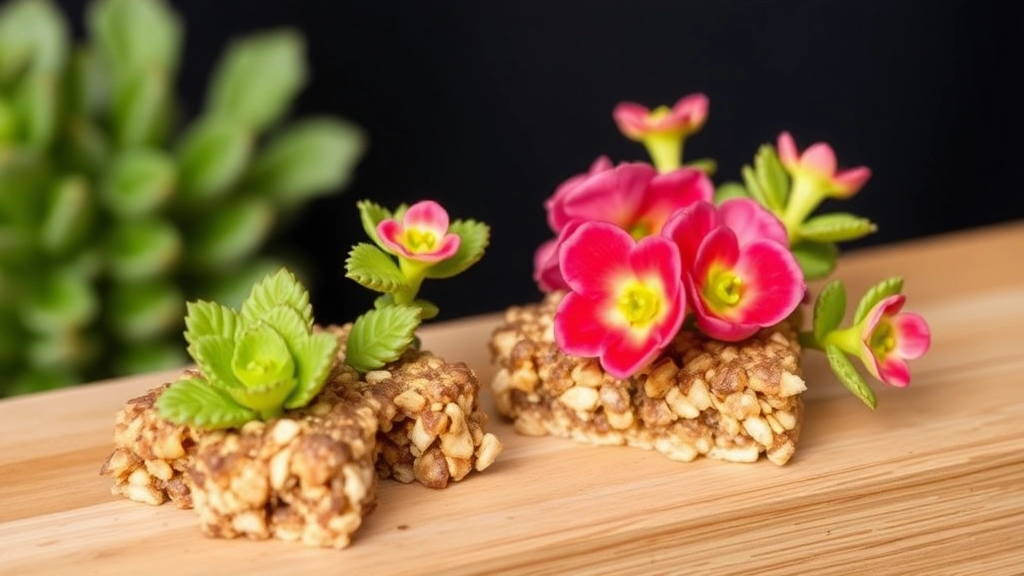
So, you’ve decided to bring some Kalanchoe flapjacks into your home or garden. Smart choice! But before you get too comfy, let’s chat about something super important—toxicity and safety concerns.
Are Kalanchoe Flapjacks Safe?
Short answer: Not entirely.
Kalanchoe species, including Kalanchoe luciae and Kalanchoe thyrsiflora, can be toxic to pets and humans if ingested. Here’s what you need to know:
- Pets at Risk: Cats and dogs may experience vomiting, diarrhea, or other digestive issues if they munch on these plants.
- Children: Little ones might be curious and take a nibble, so it’s best to keep these plants out of reach.
- Symptoms: If ingestion occurs, watch for signs like lethargy or unusual behaviour. A quick trip to the vet or doctor is always a good idea if you’re unsure.
Handling Kalanchoe Flapjacks Safely
To keep your home safe, consider these tips:
- Placement: Position your flapjacks on high shelves or in areas where pets and kids can’t reach them.
- Education: Teach your family about the plants. A little knowledge goes a long way in preventing accidents.
- Pruning Care: When pruning, wear gloves. The sap can be irritating to the skin, so it’s best to avoid direct contact.
What to Do in Case of Ingestion
If someone or something does manage to nibble on your flapjacks:
- Stay Calm: Panicking won’t help anyone. Assess the situation.
- Contact a Professional: Call your vet or a poison control centre for advice tailored to the specific situation.
- Monitor Symptoms: Keep an eye on how they’re feeling. If symptoms worsen, seek medical help immediately.
Kalanchoe flapjacks can be stunning additions to your plant collection, but it’s crucial to be aware of their potential risks.
Best Companion Plants for Kalanchoe Flapjacks in Garden Designs
When designing a garden that features Kalanchoe Flapjacks, one might wonder which plants complement their unique aesthetic and care requirements.
Ideal Companion Plants
Choosing the right companions can enhance both the beauty and health of your Kalanchoe Flapjacks. Here are some excellent options:
- Aloe Vera:
- Thrives in similar conditions.
- Adds height and texture to the arrangement.
- Sedum:
- Varieties like Sedum rubrotinctum offer vibrant colours.
- They have similar watering needs.
- Echeveria:
- These rosette-shaped succulents create a striking contrast.
- They share sunlight requirements with Kalanchoe.
- Agave:
- Adds a dramatic touch with its bold leaves.
- Both plants thrive in well-draining soil.
- Cactus:
- Varieties like Mammillaria can provide visual interest.
- They prefer similar dry conditions.
Considerations for Planting
When selecting companion plants, keep in mind:
- Sunlight: Ensure all plants receive adequate sunlight.
- Soil Type: Use well-draining soil to prevent root rot.
- Watering Needs: Group plants with similar watering habits to simplify care.
Creating a Cohesive Look
To achieve a harmonious garden design:
- Vary Heights: Combine tall and short plants for visual interest.
- Mix Textures: Pair smooth-leaved succulents with spiky varieties.
- Consider Colour: Choose companions that either contrast or complement the colours of Kalanchoe Flapjacks.
For more information on how to care for your Kalanchoe Flapjacks, check out our comprehensive guide. Additionally, if you’re interested in learning about different Kalanchoe varieties, our identification guide can be very helpful.
FAQs on Kalanchoe Flapjack Varieties
What are the unique features of Kalanchoe Luciae?
Kalanchoe Luciae, also known as Flapjacks, is a succulent with thick, paddle-like leaves that can turn stunning shades of red and orange when exposed to bright sunlight. It can grow up to 30 cm tall and produces small, tubular flowers in clusters during late winter to early spring.
What are the ideal growing conditions for Kalanchoe Luciae?
Kalanchoe Luciae thrives in bright, indirect light. It prefers well-draining soil and a watering routine that allows the soil to dry out between waterings. It’s best kept in warmer conditions, ideally above 10°C, and is resilient in USDA hardiness zones 9b to 11.
How does sunlight affect the color of Kalanchoe flapjacks?
Adequate sunlight enhances the reddish or purplish tones in the leaves of Kalanchoe flapjacks. Insufficient light can cause the plants to elongate and lose their vibrant colors, resulting in a more muted appearance.
What are the watering guidelines for Kalanchoe flapjack varieties?
Water Kalanchoe flapjacks deeply but infrequently, allowing the soil to dry out completely between waterings. Generally, watering every 2-3 weeks is sufficient, extending to every 3-4 weeks in winter. Always check the top inch of soil before watering.
How can I propagate Kalanchoe flapjacks?
You can propagate Kalanchoe flapjacks through leaf cuttings, offsets, or seeds. Leaf cuttings involve letting a healthy leaf callous over before planting it in well-draining soil. Offsets can be cut away from the parent plant and planted similarly. Seeds can be sown in light soil and kept moist.
Are Kalanchoe flapjacks toxic?
Yes, Kalanchoe species, including Kalanchoe luciae and Kalanchoe thyrsiflora, can be toxic to pets and humans if ingested. Symptoms in pets may include vomiting and diarrhea. It’s best to keep these plants out of reach of children and pets.
What should I do if someone ingests Kalanchoe flapjacks?
If ingestion occurs, stay calm and contact a professional, such as a vet or poison control center. Monitor for symptoms like lethargy or unusual behavior, and seek medical help immediately if symptoms worsen.
What are some tips for handling Kalanchoe flapjacks safely?
Position your flapjacks on high shelves or in areas where pets and kids can’t reach them. Educate your family about the plants, and wear gloves when pruning to avoid skin irritation from the sap.
References
-
Gardening Know How – Kalanchoe Luciae Care
-
The Spruce – Growing Kalanchoe Indoors
-
Drought Smart Plants – Kalanchoe Luciae
